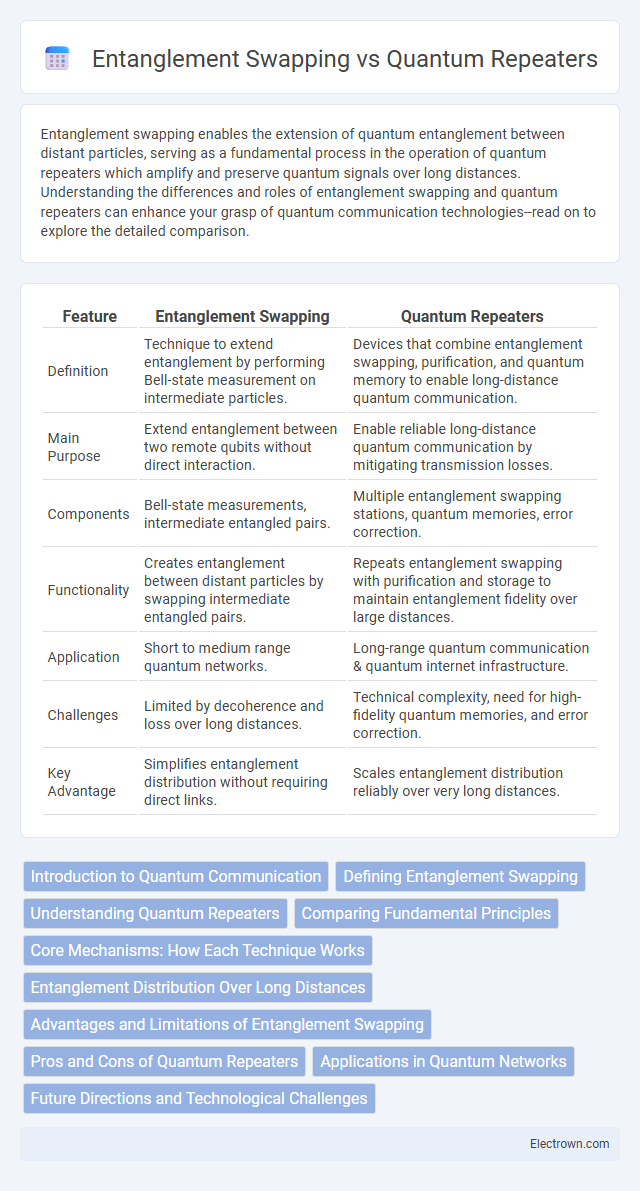Entanglement swapping enables the extension of quantum entanglement between distant particles, serving as a fundamental process in the operation of quantum repeaters which amplify and preserve quantum signals over long distances. Understanding the differences and roles of entanglement swapping and quantum repeaters can enhance your grasp of quantum communication technologies--read on to explore the detailed comparison.
Table of Comparison
| Feature | Entanglement Swapping | Quantum Repeaters |
|---|---|---|
| Definition | Technique to extend entanglement by performing Bell-state measurement on intermediate particles. | Devices that combine entanglement swapping, purification, and quantum memory to enable long-distance quantum communication. |
| Main Purpose | Extend entanglement between two remote qubits without direct interaction. | Enable reliable long-distance quantum communication by mitigating transmission losses. |
| Components | Bell-state measurements, intermediate entangled pairs. | Multiple entanglement swapping stations, quantum memories, error correction. |
| Functionality | Creates entanglement between distant particles by swapping intermediate entangled pairs. | Repeats entanglement swapping with purification and storage to maintain entanglement fidelity over large distances. |
| Application | Short to medium range quantum networks. | Long-range quantum communication & quantum internet infrastructure. |
| Challenges | Limited by decoherence and loss over long distances. | Technical complexity, need for high-fidelity quantum memories, and error correction. |
| Key Advantage | Simplifies entanglement distribution without requiring direct links. | Scales entanglement distribution reliably over very long distances. |
Introduction to Quantum Communication
Entanglement swapping enables the creation of entanglement between distant particles without direct interaction, crucial for extending quantum communication over long distances. Quantum repeaters utilize entanglement swapping combined with quantum memory and error correction to overcome loss and decoherence in fiber-optic networks, significantly enhancing communication range and reliability. Your quantum communication infrastructure depends on effectively integrating these technologies to realize scalable and secure quantum networks.
Defining Entanglement Swapping
Entanglement swapping is a quantum communication protocol that creates entanglement between two particles that have never interacted by performing a joint measurement on their respective partners. This process extends the reach of quantum networks by linking distant nodes through intermediate entangled pairs, enabling the transfer of quantum information over long distances. Understanding entanglement swapping is crucial for enhancing your quantum repeater strategies to overcome signal loss and achieve reliable quantum communication.
Understanding Quantum Repeaters
Quantum repeaters enhance long-distance quantum communication by using entanglement swapping to extend entangled states beyond direct transmission limits. Understanding quantum repeaters involves grasping how entanglement swapping connects shorter entangled links into a longer one, overcoming photon loss and decoherence. Your ability to leverage quantum repeaters is crucial for building scalable quantum networks with high fidelity and improved data transmission rates.
Comparing Fundamental Principles
Entanglement swapping is a process that enables the creation of entanglement between two distant particles by performing a joint measurement on their entangled partners, effectively extending quantum correlations without direct interaction. Quantum repeaters utilize entanglement swapping alongside quantum memory and error correction to overcome photon loss and decoherence in long-distance quantum communication. Comparing these principles reveals that while entanglement swapping serves as the core mechanism for linking entangled pairs, quantum repeaters integrate this mechanism into a scalable architecture for reliable quantum network extension.
Core Mechanisms: How Each Technique Works
Entanglement swapping creates long-distance quantum links by performing Bell-state measurements on intermediate entangled particle pairs, effectively teleporting entanglement between remote nodes without direct interaction. Quantum repeaters combine entanglement swapping with quantum memory and error correction protocols, segmenting the communication channel into shorter, more manageable links that are sequentially entangled and purified to maintain quantum coherence over extended distances. While entanglement swapping focuses on transferring entanglement, quantum repeaters integrate multiple processes to overcome decoherence and photon loss in large-scale quantum networks.
Entanglement Distribution Over Long Distances
Entanglement swapping enables the extension of entanglement links by performing joint measurements on intermediary quantum nodes, effectively linking distant qubits without direct interaction. Quantum repeaters incorporate entanglement swapping alongside error correction and quantum memory to overcome photon loss and decoherence, facilitating reliable entanglement distribution over long distances. This combination significantly improves the fidelity and range of quantum communication channels, essential for scalable quantum networks.
Advantages and Limitations of Entanglement Swapping
Entanglement swapping enables the extension of quantum entanglement between distant nodes without directly transmitting entangled particles over long distances, improving quantum network scalability and reducing loss and decoherence effects. This method offers advantages such as facilitating the creation of longer quantum communication links and supporting quantum teleportation protocols. However, limitations include sensitivity to operational errors, the need for high-fidelity entangled photon sources, and challenges in maintaining entanglement quality over multiple swapping stages, constraining practical deployment in large-scale quantum repeater networks.
Pros and Cons of Quantum Repeaters
Quantum repeaters enhance long-distance quantum communication by extending entanglement through segments, reducing signal loss and decoherence. They require complex components like quantum memories and error correction, which present technological challenges and increase implementation costs. Your ability to achieve scalable, reliable quantum networks relies heavily on overcoming these practical limitations of quantum repeaters.
Applications in Quantum Networks
Entanglement swapping enables the extension of entangled states across distant nodes without direct interaction, forming the foundation for scalable quantum networks. Quantum repeaters leverage entanglement swapping combined with error correction and purification to overcome photon loss and decoherence in long-distance quantum communication. These techniques collectively facilitate reliable quantum key distribution, distributed quantum computing, and secure quantum internet infrastructure.
Future Directions and Technological Challenges
Entanglement swapping and quantum repeaters both aim to extend the range of quantum communication by overcoming photon loss and decoherence, but scaling entanglement swapping requires precise synchronization and robust quantum memories. Future directions in quantum repeater technology involve integrating error correction protocols and developing more efficient quantum memory materials to improve fidelity and entanglement distribution rates. Key technological challenges include minimizing photon loss, enhancing quantum memory coherence times, and achieving deterministic entanglement generation to enable reliable long-distance quantum networks.
entanglement swapping vs quantum repeaters Infographic

 electrown.com
electrown.com